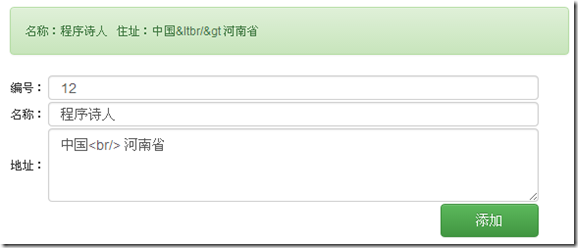在开发过程中,有时候会对用户输入进行过滤,以便保证平台的安全性。屏蔽的方法有很多种,但是今天我说的这种主要是利用MVC中的ActionFilterAttribute属性来实现。由于MVC天然支持AOP,所以我们这种过滤方式正好利用了MVC的这种特性。
下面请看步骤:
首先,当用户输入自己的名称的时候,带有类似<BR>的内容的时候,由于MVC默认是需要验证内容的,所以,会抛出一张黄页错误,提示用户:从客户端检测到潜在风险的Request值。这种页面是极为不友好的,同时也是我们作为开发最不想见到的页面,屏蔽这个错误很简单,就是在响应的页面ActionResult上面加上[ValidateInput(false)]的特性,这样当用户提交的时候,页面将不会再次对输入内容做检测。
如果容忍这样的行为,将会对系统的安全性造成威胁,所以最好的解决方法就是讲其中类似 <>等进行转义。
下面我们就来利用ActionFilterAttribute构造自己的转义过滤类:
1: using System.Web.Mvc;
2: using TinyFrame.Plugin.StrongTyped.Models;
3:
4: namespace TinyFrame.Plugin.StrongTyped
5: {
6: public class FilterCharsAttribute : ActionFilterAttribute
7: {
8: protected string parameterName = "t";
9: protected TestModel model;
10:
11: public override void OnActionExecuting(ActionExecutingContext filterContext)
12: {
13: base.OnActionExecuting(filterContext);
14:
15: //No Parameters, will return directly.
16: if (!filterContext.ActionParameters.ContainsKey(parameterName))
17: return;
18:
19: var t = filterContext.ActionParameters[parameterName] as TestModel;
20:
21: //No Entity data, will return directly
22: if (t == null)
23: return;
24:
25: //Replace chars that should be filtered
26: if (!string.IsNullOrEmpty(t.TName))
27: t.TName = t.TName.Replace("<", "<").Replace(">", ">");
28: if (!string.IsNullOrEmpty(t.TSite))
29: t.TSite = t.TSite.Replace("<", "<").Replace(">", ">");
30: }
31: }
32: }
第8行,代表我们的用户输入的实体类参数,具体的Controller代码如下:
1: public ActionResult Index(TestModel t)
2: {
3: ViewData["ConvertedModel"] = t;
4: return View();
5: }
第11行,通过重载OnActionExecuting方法,我们可以定义自己的Filter。
第19行,将获取的Input结果转换成entity。
第27,29行,将潜在的危险字符进行转义。
这样书写完毕之后,我们就打造了一个可以过滤掉关键字的Filter了。如果想要做的通用的话,需要对输入的filterContext.ActionParameters进行遍历,并通过反射构建实例,再通过反射字段值,实现通用的关键字过滤。这里我只提供思路,具体的做法就看自己了。
然后将这个方法加入到Controller中需要检测的页面的头部,即可:
1: [ValidateInput(false)]
2: [FilterChars]
3: public ActionResult Index(TestModel t)
4: {
5: ViewData["ConvertedModel"] = t;
6: return View();
7: }
这样,我们就完成了对输入数据的过滤操作,下面看看结果吧:
我们可以清楚的看到,输入结果,输出后,一对尖角号被转义了。
